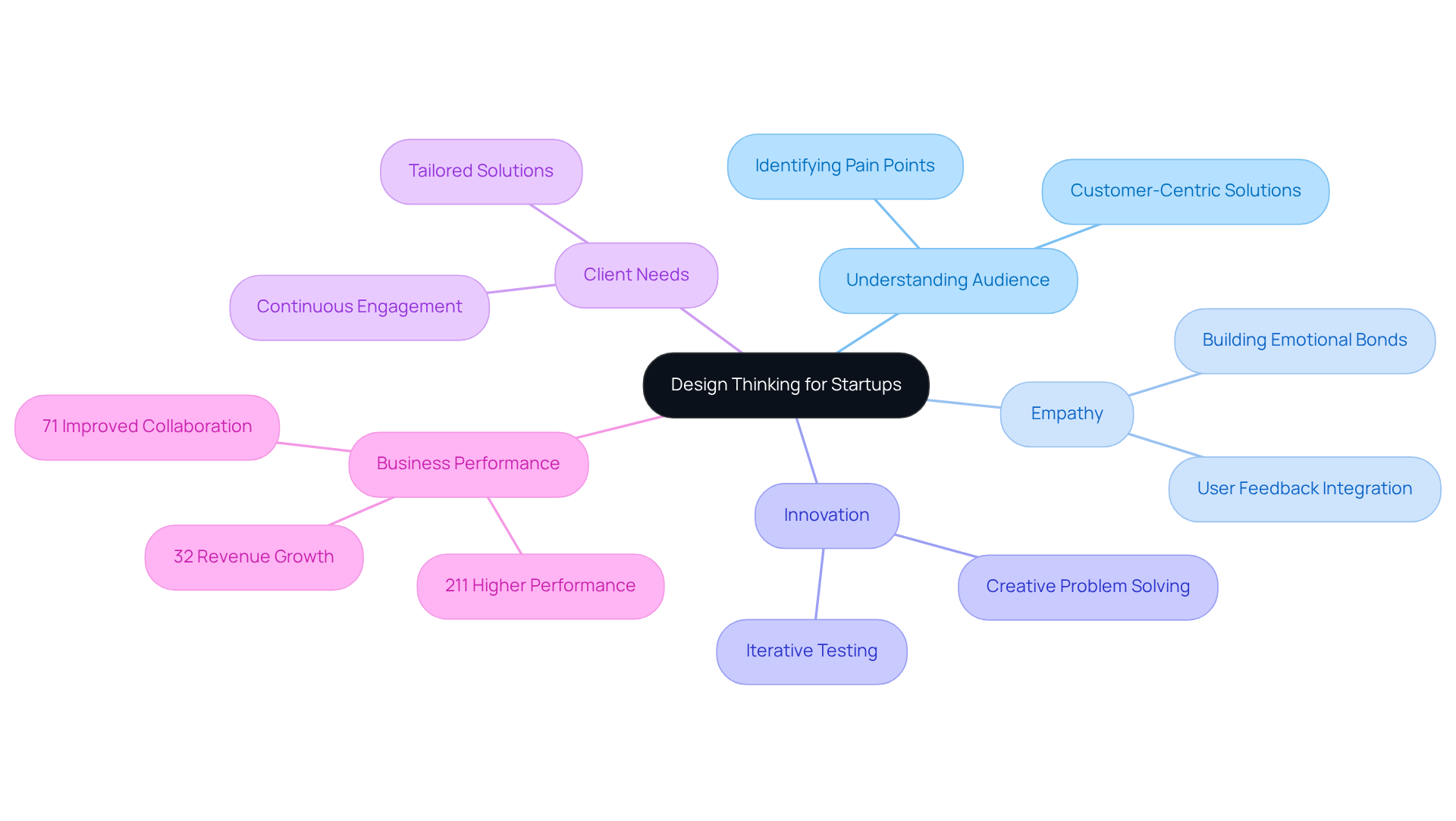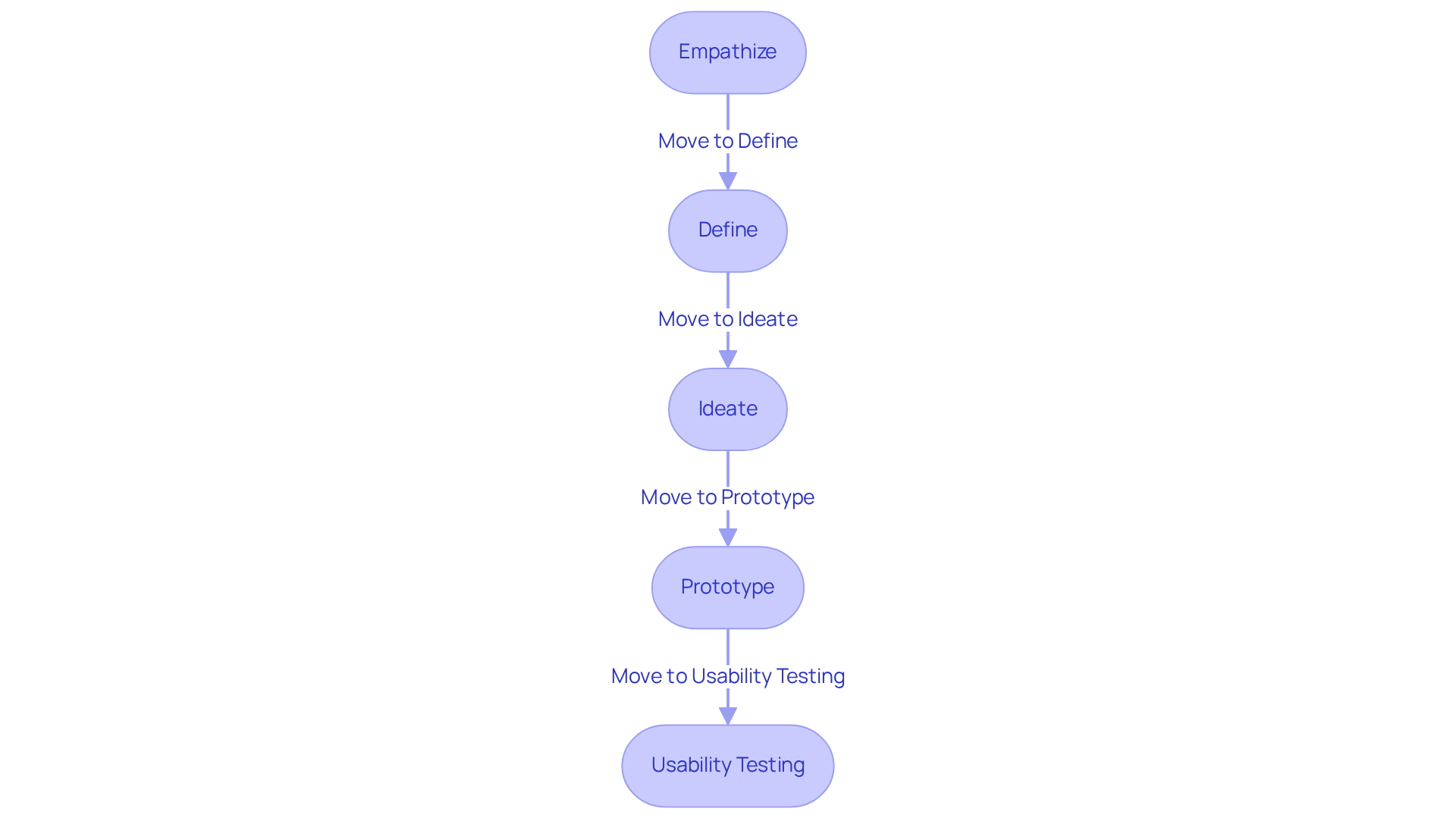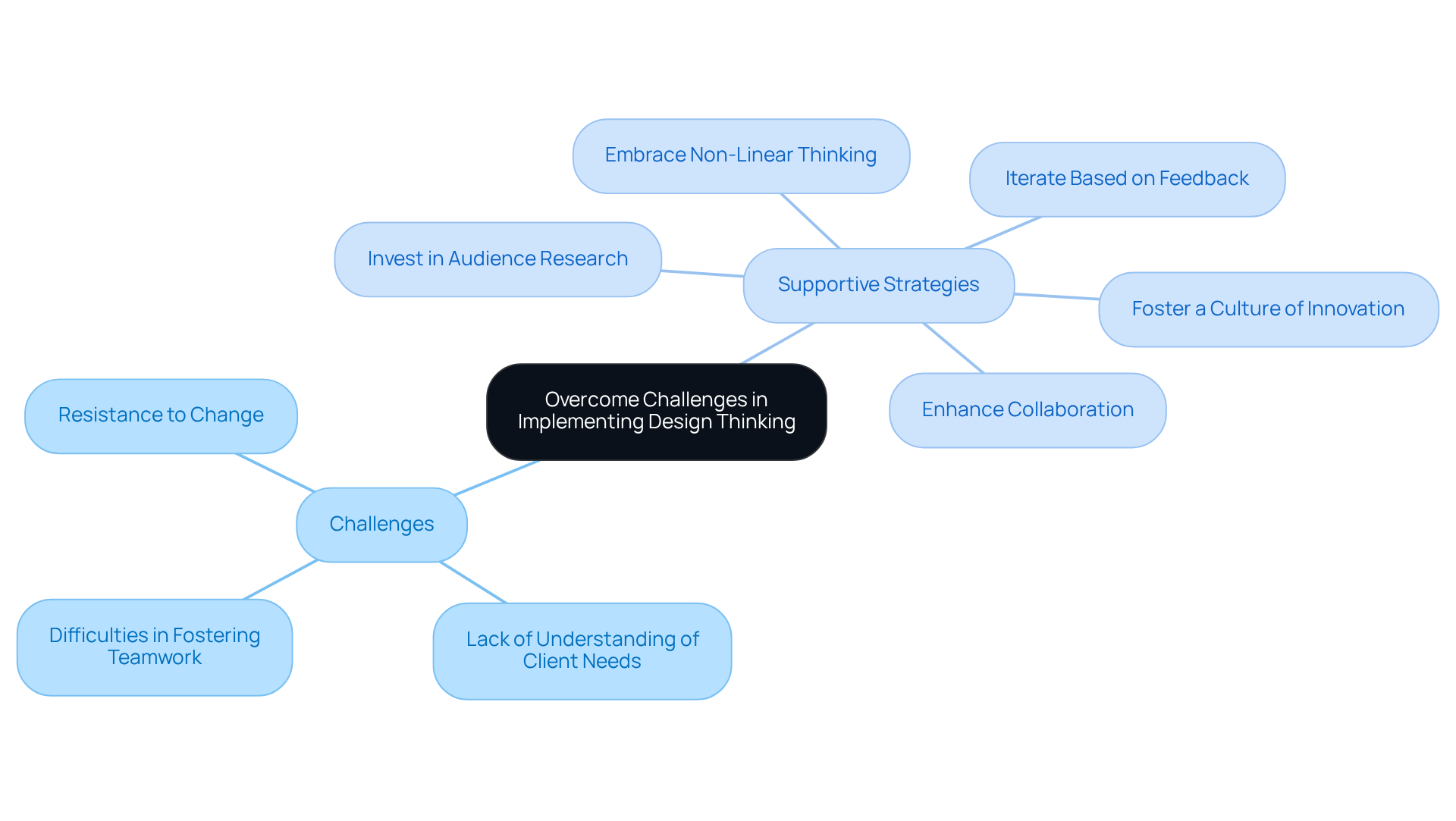Overview
The design thinking process is vital for the success of startups, particularly because it centers around understanding client needs.
Many startup founders struggle to connect with their audience, which can lead to frustration and missed opportunities.
By fostering innovation and creating impactful solutions, the design thinking process can alleviate these pain points.
The article highlights this journey by outlining the five phases of design thinking:
- Empathize
- Define
- Ideate
- Prototype
- Test
Each phase plays a crucial role in generating user-centric products that truly resonate in a competitive market.
Embracing this process not only empowers founders to address their challenges but also nurtures a deeper connection with their clients, paving the way for meaningful success.
Introduction
In a landscape where startups often struggle to connect with their audience, the design thinking process emerges as a beacon of hope. This approach, which prioritizes empathy and user-centric solutions, empowers founders to craft products that genuinely address client needs, fostering both relevance and impact.
However, as many entrepreneurs embark on this transformative journey, they face significant challenges. How can they effectively implement design thinking to drive success and overcome obstacles? This is where support and guidance can make a difference, helping you navigate the complexities of this process and ultimately achieve your vision.
Define Design Thinking and Its Importance for Startups
In the fast-paced world of startups, many founders face the daunting challenge of truly understanding their audience. This disconnect can lead to products that miss the mark, leaving genuine pain points unaddressed. offers a compassionate approach, centered around the needs and experiences of individuals. By fostering empathy within teams, the design thinking process allows startups to create solutions that resonate deeply with their clients, paving the way for innovation that matters.
When startups prioritize client needs, they carve out a unique space in a competitive landscape. This focus on the design thinking process not only results in innovative solutions but also guarantees that those solutions are relevant and impactful. Embracing a culture of creativity and collaboration is essential for navigating the complexities of the startup ecosystem. Companies that adopt creative problem-solving methods often find themselves reaping significant rewards—like a 32% increase in revenue growth and enhanced team dynamics, with 71% of organizations reporting improved collaboration.
Moreover, businesses that prioritize design have been shown to outperform their peers, achieving an impressive 211% higher performance than the S&P 500. At RNO1, we are dedicated to implementing collaborative strategies that yield real results. Our design-driven solutions are crafted to not only meet user needs but also to drive measurable success. By integrating the design thinking process into our core strategies, we empower startups to innovate effectively and achieve sustainable growth, highlighting the tangible benefits of this nurturing approach.

Explore the Five Phases of the Design Thinking Process
is structured around five essential phases that guide teams in developing innovative solutions, reflecting RNO1's commitment to design-driven strategies that enhance branding and digital growth:
- Empathize: This initial phase centers on understanding individuals and their needs through direct observation and engagement. By immersing themselves in the users' experiences, teams can uncover valuable insights that guide their next steps, ensuring that solutions are user-centric and impactful.
- Define: Here, teams articulate the core problem based on insights gathered during the empathize stage. A well-defined problem statement is crucial as it sets the direction for ideation and solution development, aligning with RNO1's goal of maximizing brand marketability through effective design.
- Ideate: In this phase, teams brainstorm a wide array of ideas and potential solutions without constraints. This encourages creativity and open-mindedness, allowing exploration of diverse perspectives that can lead to .
- Prototype: Teams create tangible representations of their ideas, ranging from simple sketches to more sophisticated models. Prototyping allows groups to investigate the viability of their ideas and recognize possible enhancements, reinforcing RNO1's design-oriented ethos.
- Test: The final phase involves gathering feedback on the prototypes from users and stakeholders. This feedback is essential for refining and enhancing the solutions, ensuring they effectively address the identified problems and contribute to RNO1's Return On Design & Digital (RODD) strategies.
Each phase of the design thinking process is iterative, allowing teams to revisit earlier stages as new insights emerge or challenges arise. This flexibility fosters a culture of continuous improvement and adaptation, particularly beneficial for startups. Organizations that embrace design thinking often experience a significant increase in their success rates, with 75% of companies indicating engagement in design thinking practices. Furthermore, design-driven companies have outperformed the S&P Index by 219% over the past decade, highlighting the effectiveness of this approach in driving innovation and growth.
Implement Actionable Strategies for Each Phase
- Empathize: It's essential to truly understand the needs and pain points of individuals. Conducting interviews and surveys can reveal valuable qualitative data. utilizes tools such as empathy maps to help visualize experiences, enhancing understanding and promoting deeper insights. Research shows that effective participant interviews can significantly improve design outcomes, with structured interviews yielding a 30% increase in actionable insights compared to unstructured formats. Furthermore, brainstorming sessions encourage creativity by inviting participants to share bold and unusual ideas, which are crucial in the ideation process.
- Define: Crafting clear problem statements that encapsulate user needs and challenges is vital. Techniques like the 'How Might We' framework can positively frame these challenges within the design thinking process, fostering innovative thinking. This approach not only clarifies focus but also aligns everyone on shared objectives, reinforcing a sense of community.
- Ideate: Organizing brainstorming sessions with diverse group members can generate a rich array of ideas. Techniques such as mind mapping help explore connections between concepts, creating a collaborative atmosphere. Data indicates that brainstorming can lead to a 20% increase in idea fluency when participants alternate between individual and group ideation. Incorporating the SCAMPER technique into the design thinking process provides a structured method for transforming existing ideas into innovative solutions.
- Prototype: Developing low-fidelity prototypes using tools like Sketch or Figma is a crucial step. Emphasizing speed and iteration over perfection allows for rapid testing and feedback cycles. Prototyping early can reduce development costs by up to 50%, as it helps identify flaws before significant resources are committed, ultimately saving time and effort.
- Conducting usability testing sessions with real participants is essential for gathering feedback on prototypes as part of the design thinking process. This information is invaluable for iterating on the structure, enhancing the solution based on user insights. Statistics reveal that usability testing uncovers 85% of usability problems, making it a critical step in the development process. By engaging with users, we can ensure that the solutions we create truly meet their needs.

Overcome Challenges in Implementing Design Thinking
Innovative thinking can often feel daunting, presenting obstacles like resistance to change, a lack of understanding of client needs, and difficulties in fostering teamwork. These challenges can weigh heavily on , leading to frustration and stagnation. It’s important to recognize these hurdles, as they can hinder progress and innovation.
To navigate these challenges, consider these supportive strategies:
- Foster a culture of innovation by encouraging open communication and experimentation within your team. This creates an environment where ideas can flourish.
- Invest in audience research; allocating resources for comprehensive insights into your clients can significantly guide your development process.
- Embrace the non-linear nature of creative thinking. Understand that the design thinking process isn't always straightforward; being adaptable as you transition between its phases can lead to unexpected breakthroughs.
- Collaboration is key—utilize collaborative tools and techniques to enhance teamwork and facilitate idea sharing.
- Iterate based on feedback. Using insights from testing allows you to make informed adjustments, reinforcing the vital role of user input in .
By implementing these nurturing strategies, you can overcome the obstacles that innovative thinking presents. Remember, you are not alone in this journey; many have faced similar challenges and emerged stronger. Together, we can create a supportive community that fosters innovation and growth.

Conclusion
The design thinking process emerges as a transformative approach that empowers startups to connect deeply with their audience and craft solutions that truly resonate. Many startups struggle to understand their clients' needs, leading to frustration and missed opportunities. By prioritizing empathy and user-centric strategies, startups can navigate these complexities, ensuring that their innovations not only meet but exceed client expectations. This approach fosters a culture of creativity and collaboration, essential for achieving sustainable growth in a competitive landscape.
Throughout the article, we explore the five phases of the design thinking process—empathize, define, ideate, prototype, and test—highlighting how each stage contributes to developing impactful solutions. Implementing actionable strategies at every phase allows startups to overcome common challenges, such as resistance to change and a lack of understanding of client needs. The emphasis on iterative feedback and continuous improvement reinforces the importance of adaptability in the face of evolving market demands.
Ultimately, embracing design thinking transcends mere problem-solving; it cultivates a mindset that encourages innovation and fosters a supportive environment for growth. Startups that commit to this process can unlock their potential, ensuring that their solutions are not only relevant but transformative. By prioritizing user insights and collaborative strategies, the journey toward startup success becomes not only achievable but a shared experience that inspires continuous evolution and improvement. Together, let us embrace this journey, supporting one another in our quest for innovation and meaningful impact.
Frequently Asked Questions
What is design thinking?
Design thinking is a process centered around understanding the needs and experiences of individuals, fostering empathy within teams to create innovative solutions that resonate with clients.
Why is design thinking important for startups?
Design thinking is important for startups because it helps them understand their audience better, ensuring that they address genuine pain points and create relevant, impactful solutions that stand out in a competitive landscape.
How does design thinking impact innovation in startups?
By prioritizing client needs and embracing a culture of creativity and collaboration, design thinking enables startups to develop innovative solutions that are meaningful and effective, leading to significant rewards.
What are some benefits of adopting design thinking in startups?
Startups that adopt design thinking can experience a 32% increase in revenue growth, improved team dynamics, and enhanced collaboration, with 71% of organizations reporting better teamwork.
How do design-driven businesses perform compared to their peers?
Design-driven businesses outperform their peers significantly, achieving 211% higher performance than the S&P 500.
What role does RNO1 play in implementing design thinking for startups?
RNO1 is dedicated to implementing collaborative strategies that yield real results, using design-driven solutions to meet user needs and drive measurable success for startups.




